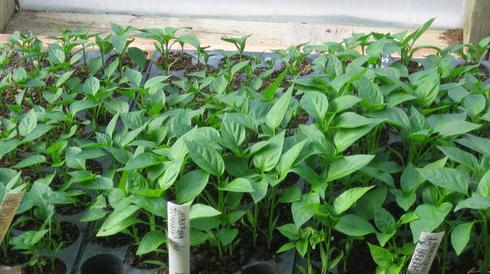 The favorite of many gardeners is sweet pepper, cultivated in various regions of the country. But in order to get a result and not work in vain, you have to follow all the rules of cultivating this heat-loving crop.
The favorite of many gardeners is sweet pepper, cultivated in various regions of the country. But in order to get a result and not work in vain, you have to follow all the rules of cultivating this heat-loving crop.
In most areas, seedlings must first be grown, and after that it is recommended to plant not in open ridges, but under cover.
Such agricultural technology allows you to collect delicious peppers even in the difficult climatic conditions of Siberia, the North-West, and the Urals. But you need to know how to choose the time when sowing this crop, some of the nuances of growing seedlings, as well as the time of transplanting plants to a permanent place in the greenhouse.
Content
- 1 Dates of sowing seeds for seedlings of pepper for a greenhouse
- 2 Seeding for seedlings
- 3 Greenhouse preparation
- 4 Soil preparation
- 5 Preparing a container for growing seedlings
- 6 Seedling care before planting in the greenhouse
- 7 Feeding seedlings
- 8 Hardening seedlings
- 9 Transplanting seedlings into the greenhouse
- 10 Reviews
Dates of sowing seeds for seedlings of pepper for a greenhouse
Gardeners with experience over many years of practice decided on the timing of sowing peppers. When calculating the days, the following factors should be considered:
- characteristics of the variety of pepper in terms of ripening;
- climate of the area;
- the weather of the current season (long or early spring);
- culture growing conditions (film greenhouse, polycarbonate, heated, without heating).
Peppers are divided into groups by maturity:
- Early varieties (it will take from 90 to 100 days before the formation of the first fruits).
- Mid-season (here the terms will be more authentic - up to 120 days).
- Late varieties (fruit formation occurs on 130-140 days).

In accordance with these data, it is necessary to grow seedlings. Her optimal age will be:
- for late varieties - 75-85 days;
- for peppers of medium maturity - 65-70 days;
- 55-60 days will be enough for early peppers.
It turns out that later varieties will have to be sown earlier than peppers of the other two groups. The calculations will be simple: from the approximate time of planting pepper in the greenhouse (and in different regions there will be dates), calculate the age of seedlings of a certain variety and add another 10-14 days (time for emergence of seedlings). As a result, they get the right date for planting seedlings.
The optimal period is from mid-February to mid-or last days of March. For example, a late variety of pepper when planting in a greenhouse around May 5-10 should be sown on February 5-10. Shoots will appear around February 20. Thus, by May 10, with proper care, get a strong 80-day seedlings. An early variety of peppers at the same time of planting in the greenhouse is sown for seedlings later, on February 20-25.
When choosing days, the moon phase schedule is taken into account, which indicates the best sowing dates for different crops, including sweet pepper.
Seeding for seedlings
Having decided on the timing, prepare seeds, containers and nutrient mixture for seedlings. Carefully approach the preparation of seed material. Purchased seeds and their own - there is no difference, they all need calibration, disinfection, germination. If on a bag of pepper seeds (usually hybrids) it is indicated that the seeds are processed, they can be sown without preliminary preparation.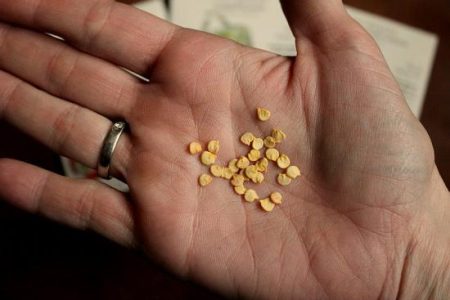
Basic tricks:
- Seed selection, for which a salt solution is suitable. In a letter of water, a tablespoon (with a slide) of salt is bred, the pepper seeds are lowered into a bag of cloth. We remove the light seeds, those that are on the surface, but we prepare the seeds for the heavy seeds that have fallen to the bottom.
- Seed disinfection. Apply potassium permanganate (2-3 grams per 0.5 liters of water), Fitosporin-M, Albit and other drugs.
- Soaking in growth stimulants (Novosil, Epin, Zircon), a solution of complex micronutrient fertilizers (Tsitovit), ash infusion (2 tablespoons per liter, leave for 24 hours, then lower the seeds for 6-8 hours). When soaking seeds using drugs, follow the instructions.
- Germination is performed in a damp tissue, constantly wetting the material. The temperature should be between + 20ºC ... + 25ºC.
Having prepared the seeds, they begin to sow them. Depth - no more than 1.5 cm, on top of the seeds slightly sprinkled with earth. Cover the containers with glass and clean them in a warm place. The temperature should not be lower than + 25ºC. Fancy peppers do not tolerate even the slightest drop in temperature in this period, and they will germinate in unheated soil for a long time. At the same time, after the pre-sowing preparation and at the optimum temperature, peppers can sprout for 5-6 days already.
The first sprouts appeared? Immediately remove the glass and put the seedlings in a bright place, reducing the temperature to + 18ºC. Such a regimen is maintained for a week, but this is required so that the seedlings do not stretch.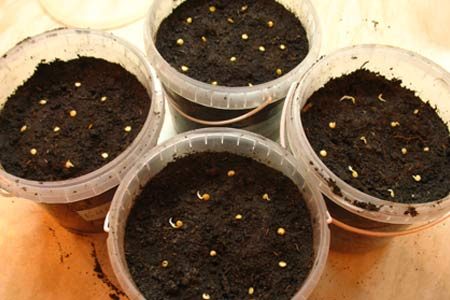
After that, seedlings are grown at + 20ºC ... + 25ºC - during the day and + 17ºC ... + 20ºC - at night. On sunny days of March and April, it is advisable to slightly shade the peppers so that the bright rays do not burn the plants.
Greenhouse preparation
It is best to grow peppers in a moody Russian climate in greenhouses or hotbeds. It is necessary to prepare the land in shelter in advance, and it is advisable to do this in the fall.
The beds are dug up, fertilizers are applied: humus, wood ash and superphosphate (approximately one glass per 1 square meter). The soil should be loose, breathable.
Peppers grow well in the neighborhood with tomatoes, but they can not be planted in a greenhouse with cucumbers. These are crops that require a different microclimate, so you cannot get good crops with this kind of cultivation.
If in the greenhouse the soil with acidity is higher than average, you will need to add additional dolomite flour or chalk.
Soil preparation
To get good seedlings, you need to prepare high-quality soil. The option for the “lazy" is to buy a mixture of soil in the store, but it is desirable that this is not just peat. It is better to prepare the soil yourself, which will require: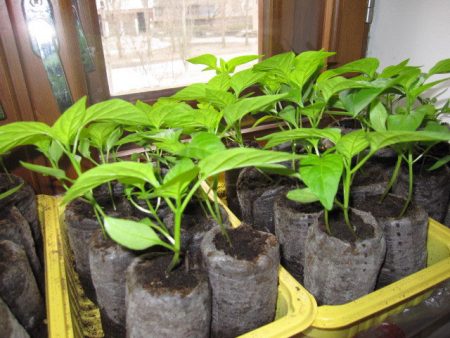
- turf or leaf land;
- humus;
- coarse sand.
Proportions: 2: 2: 1. Humus can be replaced with peat (horse), the proportion will be the same. It is not recommended to take land from under conifers, as well as under oaks and chestnuts.
The soil must be disinfected with a solution of potassium permanganate (use a saturated solution), you can also steam the ground or freeze. To improve nutrition, add ash (about one full glass per bucket) or complete complex fertilizer (no more than 40 grams per bucket of soil). Fertilizers are applied to the soil mixture only after decontamination and steaming.
Preparing a container for growing seedlings
Here, gardeners have a variety of different options, ranging from purchased pots and glasses to homemade containers. As containers use: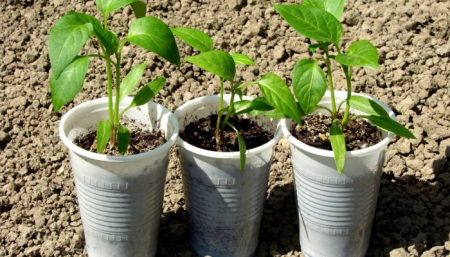
- wooden boxes;
- containers (plastic);
- pots as well as peat tablets
- glasses made of plastic, paper;
- ceramic pots.
You can sow the seeds of this culture in common boxes, and then pick. But many people believe (and not without reason) that pepper seedlings are whimsical and capricious, they don’t tolerate picking, so they immediately sow peppers in separate containers. In this case, you can sow this way: sow two seeds in each cup, and then, when the plants grow a little, leave only the strongest seedling.
Many people use milk bags and juice boxes to grow seedlings. Such a container is also suitable, but it is necessary to thoroughly rinse the containers and dry so that no liquid remains inside.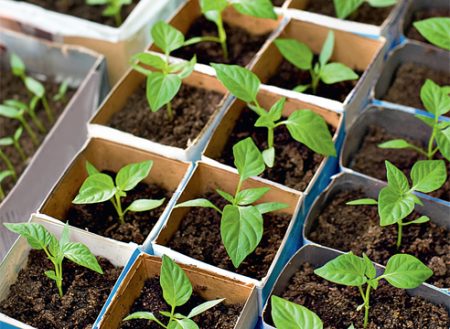
When using plastic cups, it is recommended to make a hole in the bottom through which moisture will escape. The cups themselves are installed in pallets, where excess water will flow.
Seedling care before planting in the greenhouse
When sowing peppers in common boxes with the appearance of 2-3 true leaves, you will need to pick them in separate containers. For peppers sown immediately in pots or glasses, picking is not needed.
Take care of the seedlings, conducting the main events:
- watering;
- top dressing;
- maintaining optimal temperature conditions.
Remembering that this culture is capricious, they do not allow drafts, temperature drops. Peppers are also affected by intense heat and lower degrees, so it is advisable to provide a stable microclimate during the cultivation of seedlings.
Water the seedlings sparingly, avoiding either excess moisture or overdrying the soil. Before picking, watering should be very moderate, after the appearance of 3-4 leaves, you can water more often, but again, you need to navigate by the state of the plants themselves.
Excess moisture can lead to the insidious "black legs", so it is recommended to sprinkle the surface of the soil in glasses or containers with calcined river sand. Water should be warm and must be left standing.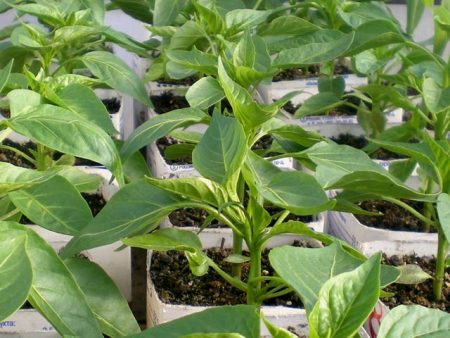
Feeding seedlings
Before the appearance of 3-4 real leaves, peppers do not feed, but later - you can already make a couple of dressings. It is convenient to use complex fertilizers, where the composition contains all the nutrients necessary for seedlings.
You can use a mixture of the following elements:
- superphosphate;
- urea.
The components are taken in the ratio: per 10 liters of water, 5 and 30 grams each. Potassium humate, wood ash are also used for top dressing. Breeding bird droppings or mullein is not recommended. Firstly, it contributes to a strong buildup of green mass, and secondly, in indoor conditions it is not entirely advisable to use organic matter because of its specific smell.
For 7-10 days before the intended planting in the greenhouse, peppers can be fed a second time, the composition for feeding will be the same as when applying fertilizers for the first time.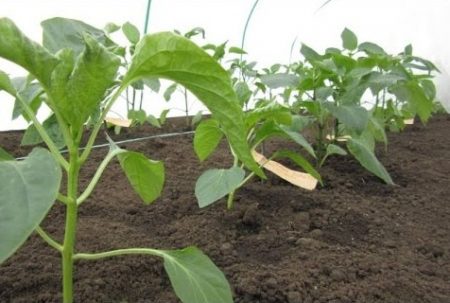
Especially you should not get carried away with the introduction of nitrogen additives, as the plants begin to “fatten”, few flowers and ovaries are formed.
Hardening seedlings
One of the common mistakes of beginning gardeners is that as soon as the appointed day of planting arrives, they immediately rush to transplant the seedlings of peppers in the greenhouse. As a result, due to a sharp change in conditions, plants undergo serious stress, adapt for a long time and take root.
Therefore, approximately 10-14 days before planting, you will need to start hardening the peppers. They are first taken out for 15-30 minutes to the balcony, the loggia with open windows and windows, to the open verandas.
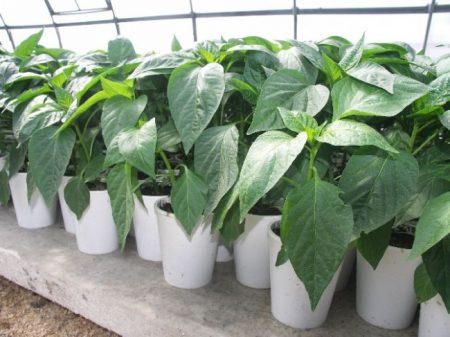
If the temperature allows, it is possible to take out boxes and cups in pallets under awnings, in arbors. Gradually, the hardening time was adjusted to several hours, bringing the seedlings home only for the night.
Such hardening will allow plants to gradually get used to fresh air, new conditions and the upcoming transplant will not cause any difficulties.
Transplanting seedlings into the greenhouse
As soon as stable heat is established, both air and soil warms up, it will be possible to prepare plants for moving them to a permanent place of "residence" in the greenhouse. This usually happens from the beginning to the end of May, but everything, of course, depends on the climate of the area and the weather.
In the middle lane, usually during warm spring, seedlings of peppers in greenhouses can be planted in late April - early May. But in the Urals or in the North-West, even in greenhouses it can be too cool at this time, therefore, the planting is carried out from the end of May.
ON A NOTE! The soil should warm up to + 14ºC ... + 16ºC (at a depth of 10-12 cm).
The age of the plants should be 60-85 days, but it depends on the ripening period of the pepper and variety. On the bush should be 7-10 developed leaves. Seedlings are carefully planted in the holes, observing the distance between the plants.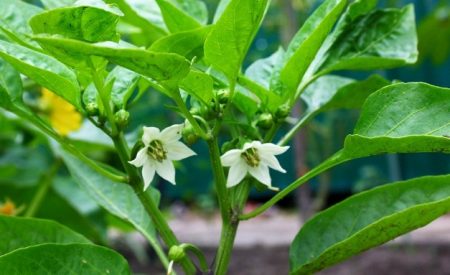
The calculation is done based on the variety:
- tall peppers are planted at a distance of at least 50-60 cm from each other;
- undersized varieties - up to 25-30 cm.
Often, descriptions of standardized peppers indicate that plants produce good yields when planted densely. This can be taken into account, especially if the area of the greenhouse is small.
It is impossible to condense high grades of peppers, as the plants will lack the sun, nutrition and they will discard the color and ovary. The best time for planting seedlings is a cloudy day or evening hours.
Seedlings are carefully planted in holes where water has already been poured, sprinkled with earth, and compacted soil. It is advisable to mulch peat or rotted humus. The next day, seedlings can be pritenit, especially if there is hot sunny weather. It is convenient to use non-woven material (even in a greenhouse), with which it is easier to create a microclimate comfortable for peppers.
The same material will help protect peppers in the case of return frosts, which are very likely in various regions of Russia even in early June. True, as experienced gardeners note, if the seedlings are strong and have already taken root, such differences are not terrible in the greenhouse.
So, correctly approaching the process of growing seedlings, you can count on getting a good harvest of delicious sweet pepper.
Reviews
Zhanna, Yaroslavl region
I sow peppers in early February, plant in a greenhouse (we have a film) in early May. But you need to look at the weather, sometimes the spring is cold, so it's better not to rush. Seeds are soaked in potassium permanganate, and then in the preparation Energen. I sow it in peat tablets, as there will be two sheets of real ones, I transplant directly in a tablet into plastic jars (0.5 liters). They have served me for more than one year, the bottom is cut in half. I put a circle to the bottom, then I fall asleep. When transplanting, I push a lump out of a glass and that's it, no complexity, and all the roots are whole. Seedlings are always strong and strong, yields are always good.
Natalia, Verkhovazhye
Be sure to always etch the seeds (unless they are already processed). But I only had such foreign ones, so they were hidden there even in dragees.
I don’t dive peppers, I immediately plant them in packages that I make from a plastic sleeve. I grow two stunted seedlings in a cup (I have them 10x10 cm in size), and tall - only one at a time. I always have 30 peppers of different varieties, enough for a family of 4, and even give them to relatives. I advise you to grow different peppers so that they are both stuffed and canned.
Lilya, Bryansk
Sowing peppers from March 10 to 15. I do not disinfect, I use only germination. Seeds are always their own, sprout excellent, in five days they stand as pretty. Already in mid-April (well, if it’s warm) I take out the boxes into the greenhouse for hardening, they still cover it with foil. Seedlings are strong, I always plant with 10 leaves and some even with buds. Pepper seems to like warmth, but if you temper and do everything wisely, it will withstand even temperature extremes.




 Calorie pepper stuffed with meat and rice - BZHU per 100 grams
Calorie pepper stuffed with meat and rice - BZHU per 100 grams Gorky pepper - the best varieties for open ground
Gorky pepper - the best varieties for open ground Hot pepper seeds - the best varieties for open ground and reviews
Hot pepper seeds - the best varieties for open ground and reviews Capsicum tincture for hair - how to use and reviews
Capsicum tincture for hair - how to use and reviews
Planted peppers purchased at the Seeds store. Two things came up. I bought red pepper in Magnet, ate it, and scattered seeds in a container with earth. On the third day, everyone hatch. So do not bother.